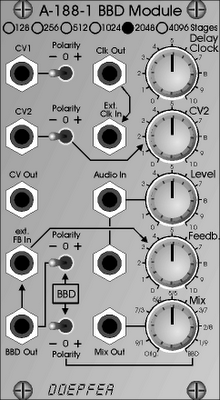 Via Doepfer: "Module A-188-1 is a so-called Bucket Brigade Device module (abbr. BBD). BBDs have been used to delay audio signals before digital delays dethroned the BBD based effect units. But BBDs have some very unique advantages (or disadvantages dependent on the point of view) over the digital counterpart which result from the special properties of the BBDs. BBD circuits can be treated as a chain of Sample&Hold units (S&H) which pass on their voltages to the next S&H in the chain at each clock pulse. A more detailed explanation – including the different types of BBDs – can be found in following chapter.
Via Doepfer: "Module A-188-1 is a so-called Bucket Brigade Device module (abbr. BBD). BBDs have been used to delay audio signals before digital delays dethroned the BBD based effect units. But BBDs have some very unique advantages (or disadvantages dependent on the point of view) over the digital counterpart which result from the special properties of the BBDs. BBD circuits can be treated as a chain of Sample&Hold units (S&H) which pass on their voltages to the next S&H in the chain at each clock pulse. A more detailed explanation – including the different types of BBDs – can be found in following chapter. In any case the sounds generated by module A-188-1 are very special. Typical applications are: Flanger, Chorus, Analog Delay or Karplus/Strong synthesis. But as the A-188-1 has a lot of very unique features (voltage controlled clock rate / delay time with extreme range, polarity switches for the CV inputs, feedback and BBD out/mix, clock and CV output of the high speed VCO, BBD clock input, feedback insert, feedback up to self-oscillation) a lot of unusual applications can be realized with the module (e.g. delay controlled by ADSR, envelope, random or sequencer with positive or negative effect). The A-188-1 also has no built-in anti-alisaing filter in order not to limit the possibilities of the module. For this the CV out is intended."
Peter Grenader of Plan B/EAR and Buzzclick Music posted the following three samples on Ah in response to requests for examples of the A-188-1 BBD Module. I asked him what else was used and if I could post the samples here. He not only gave me the thumbs up but he took the time out to type up the details below. Very cool. Enjoy.
tests_mix8.mp3
testsmix9.mp3
s2.mp3
"Audio:
This patch is a single sine going through three parallel processes: Two Miniwaves and the Doep Wave Multiplier. It's then into the Model 13 ('both' setting). The EG opening the gate is also giving the freq of the sine a strong goose (freg CV) and it's very short - an A/R at zero everything. Model 13's make short EG very useful for percussive events. The output of the M13 goes into a mixer as well as a Doep. A188 Delay (1024) which goes into the same mixer. This adds to the ringing.
Control:
The control path is all about Milton. Bank one sets up the first four degrees of a major scale . Bank two adds an accellerado to the LFO driving Milton, bank three gives a little increase in amplitude (a button) to the last note in the four position sequence.
There are various Model14's combining signals which give some dynamic presence from the keyboard aftertouch and velocity outputs and set up the equal tempered frequency offset to the sine VCO..
A midi keyboard is used to start the sequencer and the it's own stage four gate out is used to stop it. This is the benefit of having separate start/stop controls, each with external trigger inputs - you can start the sequence with one signal and stop it with another. The EG opening the Model 13 ad giving the thwap to the VCO frequency is triggered by the Milton's Obedient Clock outputs. No pulse is passed unless the sequencer is running, so stopping it at stage four allows only four events to pass and they stop in time with the sequencer halt.
The same signal which starts the sequencer (midi keyboard trigger) is also used to reset it back to stage 1. So each depression of the keyboard yields a four-note phrase. But...it's retriggerable. If you fire another midi note before Milton reaches stage 4, it'll start over again at stage one. The gesturing is created by 'dancing' on the keyboard in that fashion - allowing the sequencer bounce as much as you wish. Sometimes allowing the entire phrase to complete, sometimes resetting before it does. Once you adapt to to the feel of the sequencer's speed, you can create this gesturing quite easily."





































No comments:
Post a Comment
Note: To reduce spam, comments for posts older than 7 days are not displayed until approved (usually same day).